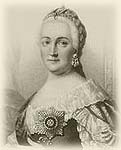
§ Russia
Catherine II
Catherine II (1729, Shtettin — 1796, Tzarskoe Selo) was a russian empress in 1762 -1796. Nee Sofia Augusta Frederique Anhalt- Tzerbst she came from a small North-German princely family. Catherine got a home education. Intelligent and ambitious, she was educated in austerity and her natural pride used to be suppressed in different ways.
In 1744 Catherine II came to Russia on Elizaveta Petrovna’s invitation. After being baptized into Orthodoxy and having got the name of Ekaterina Alexeevna she married to a high prince Petr Fedorovich (Peter Ulrikh), later Peter III. Whilst her husband’s indifference and a strictly regulated life of the court, surrounded by evil-wishers, Catherine read a lot getting to know the works on history, law, the works of French enlighteners and learnt Russian. In 1754 Catherine II gave a birth to the son, the fiture emperor Paul I. Elizaveta Petrovna’s disease and her husband’s indifference made possible either her deportation or a seclusion. Her position became unstable after the Peter III accession on throne who was getting more and more hostile to her.
Supported by the Guard regiments Catherine II made a bloodless revolution on June 28th, 1762 and became an absolute empress. «Tartuth in a dress and a crown» (A.S.Pushkin), unprincipled, ambitious, imperious she knew to win people’s favour and selected well her new collaborators. Trying to imitate Peter I, Catherine II brought about an active reformatory work. In order to consolidate her own power, searching for fame she took on a role of an «enlightened monarch» who was reorginizing the lifestyle on wise principles following the advice of the French philosophers — Enciclopedians. V. O. Klyuchevsky wrote: «In the society that had lost the sense of right even such a fortuity as a right personality of the monarch would either pass for a legal guarantee».
In 1767 after having refused of N.I.Panin’s administrative reform Catherine II convoked «The commission for the composition of the new Code project» writing for it «Instructions» compilated from the works of such enlighterers as Montesque, Bekkaria and others. The Assembly of legislators got out of control and, for that reason, became disagreeable. It was dissmissed in 1768 under the pretext of the war with Turkey and it has never been convoked anymore. The travels through Russia in 1763, 1764, 1767 didn’t give the empress a clear idea of the real situation of peasants as she saw only the things she was shown while she was shown only the things pleasant to see. Having made herself sure of a bad administrative system, Catherine II carried out the Senate reform. The Senate was divided into 6 departments and having lost its meaning of the State machinery administration body it turned into a highest administrative and judicial institution. After having faced financial difficulties, Catherine II carried out a laicisation of church lands (i.e. turning them into a secular property) in 1763-1764 that not only let her fill up the treasury but it also helped to continue and to finish the neutralisation of the clergy as a political force began by Peter I. If B.Y.Mironovich’s plot hadn’t been a serious threat for Catherine II it can’t be said the same about Pugatchev’s peasant revolt in 1773-1775 proved her that she could rely only on the nobility. After the rout of Pugatchev Catherine II used all possibilities to create a powerful absolute State. In 1775 «An Establishment for the provinces control» allowed her to create numerous local administrations. In 1785 «The letter granted to the nobility» and here by «The letter granted to the cities» put in order the social structure of a russian society divided into 5 estates: those of nobility, clergy, the merchant class, petty burgeosie (lower middle class) and serves. The power over the last ones was constantly increasing.
The Catherine II reign was called «The Golden Age» by the noblemen. Feudalism got on the top of its development within this period.
Trying to consolidate the Empire, Catherine II used to write about russian outlying districts: «Malaya Russia, Leafland and Finlandare provinces… These provinces … are to be brought by the easiest means into a such position that they become Russified and stop hankering after the forest as wolves do».
The Crimea and the Northern Caucas, the Polish Kingdom were the target direction of Russian expansion, where brilliant victories of P.A.Rumyantzev-Zadunaysky, A. V. Suvorov, F. F. Ushakov contributed to the development of the russian self-consciousness and increased ethnical diversity, aggravating national problems.
Either Eastern borders of the State were not set aside. On the 22nd of December 1786 Catherine II signed the «Order» to the Admiralty Board about a squadron departure to Kamchatka in order to protect Russian lands: «…on the occasion of encroachment upon the trade and haunting in the Eastern Sea from the side of English manufacturers and in order to preserve our right on the lands open by russian navigators we command to our Admiralty Board to send two ships from the Baltic sea armed on an English capitan Cook’s example and those used for the similar explorations by other navigators, as well as two sailing boats or other ships on a better discretion we prescribe them to travel all over the Good Hope Cape and to go to Kamchatka from that point making its way through the Sonds Strait and leaving Japan on the left side».
The famous historian V. O. Klyuchevsky wrote: «Foreign policy — the most brilliant side of Catherine’s State activity — would produce the strongest impression on her contemporaries and the nearest descendants».
Translated by Bochkova Elena
| 






















